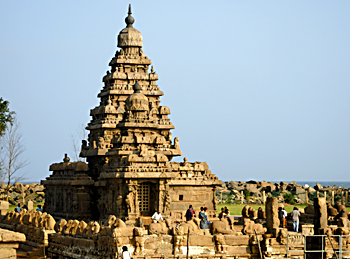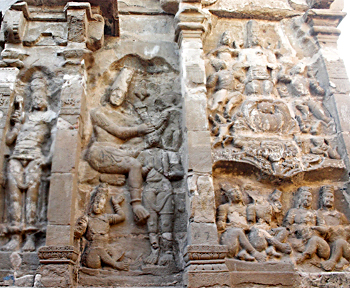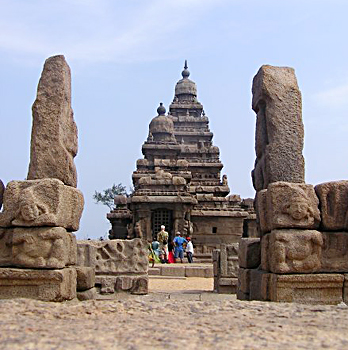 Tamil Nadu in South India is a store house of a fairly large number of temples. Pure Hindu culture still thrives here. The temples of Tamil Nadu reflect the typical south Indian culture and they are built in the Dravidian style of architecture. Most of the temples have lofty towers and they are the torch bearers of the glorious heritage of Tamil Nadu. In Mahabalipuram there are many small stone temples and cave temples. Rock-cut architecture was gradually replaced by structural monuments which were built with bricks and stones. The Shore Temple at Mahabalipuram is the best example of structural architecture. The evolution of the south Indian style can be seen in the step like towers. The formation of the gopura can be seen in Ganesha Ratha, a stone sculpture. The mature style of this temple can be seen in the Vaikunta Perumal Temple of Kanchipuram. Colonial architecture is also an imperative part of Tamil Nadu and is perceived in the city of Chennai.
Tamil Nadu in South India is a store house of a fairly large number of temples. Pure Hindu culture still thrives here. The temples of Tamil Nadu reflect the typical south Indian culture and they are built in the Dravidian style of architecture. Most of the temples have lofty towers and they are the torch bearers of the glorious heritage of Tamil Nadu. In Mahabalipuram there are many small stone temples and cave temples. Rock-cut architecture was gradually replaced by structural monuments which were built with bricks and stones. The Shore Temple at Mahabalipuram is the best example of structural architecture. The evolution of the south Indian style can be seen in the step like towers. The formation of the gopura can be seen in Ganesha Ratha, a stone sculpture. The mature style of this temple can be seen in the Vaikunta Perumal Temple of Kanchipuram. Colonial architecture is also an imperative part of Tamil Nadu and is perceived in the city of Chennai.
Tamil Nadu is located in the southern most part of the Indian peninsula. Archeological evidences have confirmed that Tamil Nadu dates back to the pre historic period. It was a home for Tamil kingdoms like Chera, Chola, Pandya and Pallava. Dravidian architecture reached its summit during the reign of the Pallavas. The Shore temple was built during their rule. The temple architecture of the Pandyas forms a major part in the architecture of Tamil Nadu. The Meenakshi Amman temple at Madurai and the Nellaiappar temple at Tirunelveli are among the best examples of Pandyan Temple architecture. The Chola Dynasty became stronger in the 9th century and this power is reflected in their architecture which was on a magnificent scale. During the 11th century temples were constructed in Tanjavur and Gangaikondacholapuram. The vimana or shrine of one was made strong and straight and manlike and the other was made beautiful with a lot of curves and very feminine. In the 13th century the power of the Cholas weakened and the Vijayanagar Empire came to prominence. Temple architecture experienced a massive change in the style of construction. From then on the temples became larger, more complex with a great number of buildings inside a wide rectangular area. The main shrine became small and could not be distinguished from the outside. The gopuras on the outer walls became larger and more magnificent, as can be seen in those at Madurai where the gopura stands more than seventy meters tall.
In the 13th century the power of the Cholas weakened and the Vijayanagar Empire came to prominence. Temple architecture experienced a massive change in the style of construction. From then on the temples became larger, more complex with a great number of buildings inside a wide rectangular area. The main shrine became small and could not be distinguished from the outside. The gopuras on the outer walls became larger and more magnificent, as can be seen in those at Madurai where the gopura stands more than seventy meters tall.
The evolvement of stone architecture right from cave tem¬ples to the rock cut temples and early stone temples can be seen in Mahabalipuram in sequence. Extensive constructions have been made in the cave temples and are constructed in the south Indian style. It will be noticed that the pillars of early times were square in plan. At the base of the pillars are sculptures of lions which are a feature of Pallava structures. The five stone temples in Mahabalipuram sculpted out of rocks one behind the other came to be called as Pancharatha. It is very interesting to note that the style of each temple is different and becomes a catalogue of the temple styles of the time. The Baktavatsala Temple of Tamil Nadu reflects the ultimate in Dravidian architecture.
 This temple town of Kanchipuram was the capital of the Pallava dynasty from 7th to 9th century. It has many ancient stone temples and is famous for the Kailashanatha and Vaikuntaperumal temples. The evolution of the South Indian architectural style from Mahabalipuram to Kanchipuram is noteworthy. The architecture varies from simple cave temples to the Baroque style. The whole temple of Kailashanatha has been built with sandstone. Hence the quality of the sculpture is the best of its kind and the detailing is complete. This temple looks like a stable pyramidal type of structure. The Vaikunta Perumal temple is dedicated to Lord Vishnu. The vimana resembles the Kailashanatha Temple, but the precincts are very different. Instead of the small shrines as in the other temple, this one has a surrounding corridor with lion pillars very near the vimana. The architecture of the wooden palace of Padmanabhapuram is of the Malabar west coast style. Other than the royal temple which is made of stone, all other-buildings in the palace are made of wood. The roof is slated and sloping with wooden engravings on the gable. The walls are latticed to allow in air. All this has many common elements with the wooden constructions of south East Asia. Unpainted teak wood has been used. The imposing appearance of the combination of white walls and slate brown is the result of the search for comfort in the residential architecture, rather than reflecting grandeur.
This temple town of Kanchipuram was the capital of the Pallava dynasty from 7th to 9th century. It has many ancient stone temples and is famous for the Kailashanatha and Vaikuntaperumal temples. The evolution of the South Indian architectural style from Mahabalipuram to Kanchipuram is noteworthy. The architecture varies from simple cave temples to the Baroque style. The whole temple of Kailashanatha has been built with sandstone. Hence the quality of the sculpture is the best of its kind and the detailing is complete. This temple looks like a stable pyramidal type of structure. The Vaikunta Perumal temple is dedicated to Lord Vishnu. The vimana resembles the Kailashanatha Temple, but the precincts are very different. Instead of the small shrines as in the other temple, this one has a surrounding corridor with lion pillars very near the vimana. The architecture of the wooden palace of Padmanabhapuram is of the Malabar west coast style. Other than the royal temple which is made of stone, all other-buildings in the palace are made of wood. The roof is slated and sloping with wooden engravings on the gable. The walls are latticed to allow in air. All this has many common elements with the wooden constructions of south East Asia. Unpainted teak wood has been used. The imposing appearance of the combination of white walls and slate brown is the result of the search for comfort in the residential architecture, rather than reflecting grandeur.
Tiruvannamalai is a temple town of Tamil Nadu with more than hundred temples. The Arunachaleshwara temple with the holy Arunachala Mountain overlooking the town is the main attraction here and the whole town is focused on this temple. The Ginjee fort is a huge fort of Tamil Nadu and encompasses palaces, public offices, temples and mosques. There are a lot of temple towns in Tamil Nadu where pilgrims gather in large numbers. Among them is the temple of Nataraja where the line of pilgrims never stops. The construction of this temple belongs largely to the Chola era and here is an excellent example of uniformity in style. The architecture of the budding gopura that was seen in Mahabalipuram and Kanchipuram during the Pandya dynasty attained style and grew more organised during the Chola period. The Brihadeswara Temple is noted for its architectural finish and beauty. The Ranganatha temple of Tamil Nadu has the largest precincts in India. Inside the precincts there are tanks, small shrines and many pillared halls, all with the Vijayanagar style of sculpture and decorations. It was not only a place for praying but was also a facility for people to meet. The Nayaka palace of Tanjavur has a heavy Islamic influence with arches and domes. The castle tower built during the 17th century looks like the vimana of a Hindu temple.
Chennai, the capital city of Tamil Nadu has many colonial buildings most of which belongs to the 19th century except the Holy Mary Church, which was built in 1680 inside the St.George Fort. The architecture of Tamil Nadu will enchant the tourist with their divine charm. The plethora of temples with their detailed structural design is indeed a delight for the visitors.



















